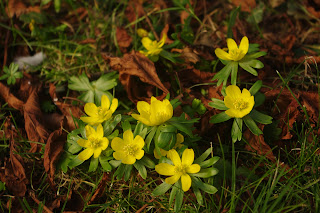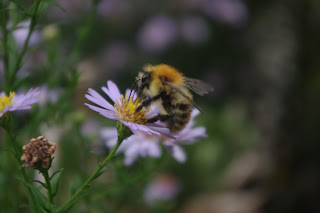Here is a nice combination (as planted by Jif at the music school). The speckled leaves are Lungwort; like most shade tolerant species Pulmonaria flower in spring. The pink flowers are Cyclamen hederifolium, one of the very few shade loving plants to flower in autumn.
A diary of back garden botany, urban ecology, rural rambles and field trips to the middle of nowhere...
Friday, 29 September 2023
Wednesday, 27 September 2023
Not much to see at the moment but this is a very vigorous plant: Rosebay Willowherb (Epilobium angustifolium). On the whole it's too vigorous for gardens unless very large and wild but I have a bed at the front of the house where the spread would be contained.
The simplest form of propagation is root division, as above. There is a large patch of Rosebay Willowherb at the music school so I dug around a stem and grubbed out a section of rooty rhizome with it. It was once commonplace to sell plants fresh out of the ground bare root before growing stock in plastic pots became the norm. It still happens, I recently purchased five of Purple Loosestrife from Shipton Bulbs which were dispatched bare root. They looked rather like a collection of twigs but they too are vigorous.
Epilobium angustifolium is said to be a native of this island but then again it's also a North American species; for example I saw some growing by a spring in Northern California when I was hiking on the Pacific Crest Trail. Old botanical records note that it was sparse in the UK which is curious since it's so prolific now.
My father tells me that it grew all over London after the war colonising bomb sites and derelict land. Rosebay Willowherb is known to be a pioneer plant of burned ground hence it is sometimes referred to as Fireweed. When in flower in summer it is fiery indeed...
Monday, 25 September 2023
These knobbly corms are Winter Aconites (Eranthis hyemalis). A few specialist nurseries like Shipton Bulbs cultivate and sell them for autumn planting. Strictly speaking a corm is a swollen but solid underground stem; a true bulb is also a modified stem but comprises layers of leaves around a bud. Bulbs and corms are storage organs of nutrients for future growth.
Winter Aconites are an introduction from the southern Mediterranean that has naturalised here and there in the UK. For example there is a rather fine patch near Hitchin that I make a point of going to see most years. [see entry dated 16th. February 2017]
I would like them to naturalise in my garden but London clay doesn't suit them. However there is one spot where a few have taken -the soil seems a bit lighter there- so I'm planting some more. They are delightful in late winter/early spring so here's hoping...
Friday, 22 September 2023
One hundred Ramsons (Allium ursinum) courtesy of Shipton Bulbs. Wild Garlic is another name for this species; the cigar-shaped bulbs and tendril-like roots are pungent. Ramsons can be prolific (and reeking) in wet woods in late spring, for example see my entry dated 29th. April 2019 concerning Gopher Wood in Wiltshire.
As good a garden plant as many other bulbs A. ursinum is becoming more widely available for autumn planting. In the past only specialist nurseries like Shipton cultivated it but the interest in wild food and wild gardening has no doubt enhanced its appeal. Easy to grow in a shady spot as long as the soil is very moist.
Wednesday, 20 September 2023
Still ruminating on my overnight trip to Dorset last week. Only two days but it's looking like they may have been the last of the Indian summer we experienced in September. Hopefully some mild and mellow weather still to come but it feels properly autumnal now.
As mentioned I had a pint at the Crown Inn in Punknowle; Palmer's beer brewed in nearby Bridport since 1794. I sat by a window looking out on the village church opposite. I reflected that so many of our villages are based around a pub and a church, often right next to each.
The pagan and the spiritual? The dialectic between the physical and the Devine? Village life would have centred around one or other or both of these places, still does sometimes. Anyway, for me beer is holy.
Monday, 18 September 2023
We are reaching the tail end of the season for flowers and pollinators. So I was I was pleased to see this Painted Lady right at the end of my quick trip to Dorset last week. I was waiting for a bus in Abbotsbury to take me to Weymouth to catch the train back to London. A clump of Red Valerian was still in flower in a nearby front garden and this beauty suddenly appeared.
To quote the website of Butterfly Conservation: "The Painted Lady is a long-distance migrant, which causes the most spectacular butterfly migrations observed in Britain and Ireland. Each year it spreads northwards from the desert fringes of North Africa, the Middle East and Central Asia, recolonising mainland Europe and reaching Britain and Ireland. In some years it is an abundant butterfly, frequenting gardens and other flowery places in late summer."
I can't say I have found it to be abundant but perhaps it's not surprising to see one on the South Coast where it would first make land on its long journey.
Sunday, 17 September 2023
Friday (the second day of my whistle stop trip to Dorset) I woke early feeling a bit damp and chilly. No rain overnight but the greenery was sopping wet with dew. I brewed coffee, packed my tent and headed to the bus stop in the nearby village of Uplyme.
The X53 between Axminster and Weymouth is a handy service to hop on and off at various points along the coast. My first stop was Swyre, a hamlet at crossroads where we used to go on holiday when I was a child. I stood on top of a wartime pill box looking out to sea. I've stood at that spot every now and then for most of my life. It still thrills me.
Then I walked a mile or so inland to the village of Punknowle, specifically the Crown Inn where I stopped for a pint. I suppose Dorset is the place where I first engaged with the English landscape. England - and indeed our dis-United Kingdom- is full of landscapes but for me Dorset is the primal landscape.
I suppose I think fondly of an older, more dilapidated Dorset. In good and bad ways the county has become considerably more affluent in recent times. But a falling down shed is so much more interesting than a luxury house.
Then I walked back to the coast road and caught another X53 to Abbotsbury. Surely one of the most scenic routes in Britain and the top deck of a double decker the ideal way to see it.
Abbotsbury is overlooked by a chapel on a hill.
From one side of the chapel you look back towards the village and beyond. Abbotsbury Plains is an undulating landscape of lynchets, lime kilns, stone circles, long barrows and other mysterious traces of ancient Albion.
From the other side of the chapel you look towards the Isle of Portland and the Chesil Beach, that long strand of shingle that separates the Fleet Lagoon from the sea.
I rounded off my afternoon in Abbotsbury by walking down to the beach and gazing across Lyme Bay in the direction of Lyme Regis. In fact this view looks directly down the Jurassic Coast to the spot in yesterday's post where I photographed the coastline.
Then I caught my third bus of the day to Weymouth which still has the flavour of a cheery/gaudy seaside resort. I strolled along the promenade but I didn't have my bucket and spade with me so I headed for the station. I got the train back to London reflecting on my brief sojourn in Dorset for the first time in four years. I won't leave it so long until my next visit.
Saturday, 16 September 2023
A quick run to the coast on Thursday and Friday. I have visited Dorset throughout my life beginning with family holidays as a child. But there has been quite a long gap since the last time- September 2019- what with the pandemic and life in general.
So I caught the train to Axminster then bus to Uplyme where I pitched my tent in an idyllic spot on an old school campsite I've stayed at before. Actually Uplyme is just in Devon but I'm cosmopolitan so that's ok.
Then I walked beside the River Lym into Lyme Regis (which is in Dorset) and looked across the bay along the Jurassic Coast famous for its landslips and fossils.
Wednesday, 13 September 2023
The Asters in the front garden are looking bloomin' luvly.
Also known as Michaelmas Daisies. They have in effect become a naturalised wildflower, for example they are often seen in great drifts along railway embankments. Only the Sea Aster is native to the UK, other species from Europe and North America are garden escapes and hybrids of escapees.
Moreover the genus Aster has now been split into several additional genera Eurybia, Symphyotrichum etc. The ones in the front garden probably self-seeded there so I'm not going to try to untangle their lineage.
As the last flowers of summer bloom so too the last bees on the wing seek them out.
Monday, 11 September 2023
Thursday, 7 September 2023
Tuesday, 5 September 2023
One of the most common butterflies: the Large White.
I think the two spots on each wing indicate this is the female of the species.
Also known as Cabbage White, and they do indeed like a bit of brassica. Or rather the caterpillars do which is what does the damage. The Large White will lay up to a hundred eggs two or three times a year which results in a lot of hungry mouths to feed.
These photos were taken on the allotment and I notice my neighbours have netted their cabbages to protect them.
Monday, 4 September 2023
Late summer wildflowers were the theme of last week's entries. As daylight hours decrease so too the number of flowering plants (and I'm sorry to say the nights are drawing in).
Gardeners face the same situation and seek out species to extend the season. Case in point Sedums flower well into September and October. I think this one is the form known as 'Munstead Red'?
Many plants in the genus have been renamed Hylotelephium but try saying that with your mouth full. I'll stick with Sedum or the colloquial name Stonecrop.
NB gloriously warm and sunny this week which helps stave off the transition into dormancy (mine as well as the plants).
Saturday, 2 September 2023
Friday, 1 September 2023
Devil's-Bit Scabious (Succisa pratensis) flowers in grassland from late summer into autumn. Said to be a plant that needs moist soil but I see S. pratensis growing on calcareous soils in places like the South Downs and Knocking Hoe which are free draining and dry. Generally on sloping ground so perhaps they get the benefit of rainfall as it drains downhill?
Various sources note the common name comes from archaic folklore that the roots are short because the devil bit them off. Hard to imagine this would become the common parlance but common names of plants are frequently obscure and curious.
Subscribe to:
Comments (Atom)


































